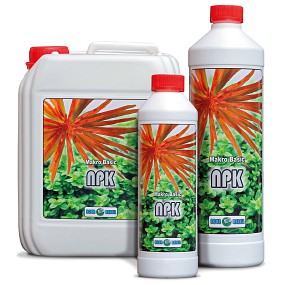What do aquatic plants need to grow in the aquarium?
This is a question every beginning planted tank keeper asks when reading up on the subject of aquatic plants and fertilization. We'd like to explain briefly which components are crucial for the successful cultivation of aquatic plants. We have identified four factors on which we have based our fertilizer system:
- Light:

Every plant needs light for photosynthesis. Frequently beginning planted tank keepers hear the following piece of advice when their plants do not grow well: "Stock up on lights." However, this might not be the solution to the problem in every case. Different plant species have different requirements when it comes to light intensity. There are plants that are easy to care for, which do not need a lot of light; reddish stem plants, in turn, need much more light (and nutrients). Renowned manufacturers and aquatic plant nurseries mark the plants they sell with a "traffic light system". The plants in the green category are easy to care for, like mosses, ferns, Anubias and so on. They have low requirements regarding the light and the nutrient supply. On the other hand, the plants in the red category are highly demanding. Most fast-growing stem plants with red leaves fit this category.
- CO2:

When you fertilize your aquarium with CO2 you supply your plants with an element that is usually deficient in aquaria without a CO2 injection system. The addition of CO2 is an absolute must if you want to cultivate fast-growing stem plants, and even the undemanding plants in the green category speed up their growth, and their health improves significantly when carbon dioxide is added. No planted tank should have to exist without a CO2 injection system. There are solutions for every budget, low or high — low-priced Bio-CO2 injection systems for beginners or the more expensive yet much more efficient systems that use pressurized refillable carbon dioxide bottles.
- Micro fertilization with an iron fertilizer:

This point brings us to the part that deals with liquid fertilizers. Besides many other trace elements, plants mostly require iron. This element is crucial for their green leaf color. All the components aquatic plants need are contained in a so-called complete iron fertilizer. Usually this liquid fertilizer comes in a bottle, and you add a certain amount to your aquarium, per week or even per day.
- Macro fertilization with NPK:

This is an aspect of fertilization that many aquarium keepers sadly neglect. NPK stands for the elements nitrogen (N), phosphorus (P) and potassium (K), which are needed by the plants, and in relatively large amounts. Nitrogen and phosphorus compounds that can be taken up by the plants may be created in the aquarium by the activity of microorganisms, which break down fish excrements, dead plant parts and fish food, however, these sources are insufficient especially in tanks with many plants. The plants need more than they get. And the most crucial macro element, potassium, does not even form part of the waste material in an aquarium. Still, the plants require it. NPK fertilizers are offered by many manufacturers, usually in the form of liquid fertilizer, either as a well-balanced mixture containing all three elements, or as single-component fertilizer that comes in individual bottles.
All those who deal with the fertilization of aquarium plants should be well aware of these four factors. They form the basis for a well-balanced system and beautiful plant growth.